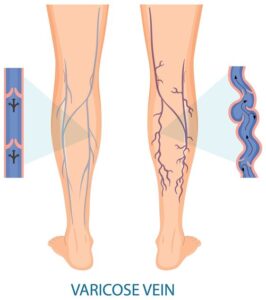Understanding Varicose Veins: Causes, Symptoms, and Treatment Options

What is a Varicose Veins
Varicose veins are mostly a cosmetic issue for many people. But these blueish veins right under the surface of the skin can also cause problems like heavy legs or cramps in the lower legs (calves). Varicose veins are most commonly found on the calves or on the inner leg. They develop when blood builds up in the superficial veins of the legs. These veins then typically become swollen, raised and appear purple or blue through the skin.
Varicose veins are a common condition that affects millions of people worldwide. While they are often seen as a cosmetic concern, they can also cause discomfort and, in some cases, lead to more serious health issues.
Causes of Varicose Veins
In general, this illness is brought on by elevated blood pressure in the legs, which causes veins to enlarge and bulge. Leg veins that seem bumpy or gnarled are caused by persistently stretched vein walls in these veins due to increasing blood pressure. The lower thigh is where these veins usually appear, and they might hurt.
Certain elements could play a role in the development of the same illness. Being a woman is the largest contributing factor because women are far more likely than men to get this illness. Among the particular reasons for varicose veins are:
Pregnancy:
This venous problem strikes many pregnant women in the later stages of their pregnancy. Pregnancy-related hormonal changes alone may be sufficient for some women to develop these veins, but for others, the extra weight gain during pregnancy is sufficient to produce abnormal blood flow in the legs. Pregnancy-related increases in blood pressure and hypertension can lead to the development of spider veins and other vein disorders.
Lifestyle :
The onset of this illness could be attributed to a few lifestyle choices. One typical lifestyle factor is working in a profession that requires you to stand a lot, which puts extra strain on your legs’ veins and causes the walls of those veins to enlarge. Sedentary lifestyles, which have a detrimental effect on blood circulation, are another prominent culprit. Additional lifestyle variables could be inadequate exercise, smoking, or bad eating habits.
Genetics :
An further role in the development of this vein problem is your genetic makeup. It is possible that you will be more prone to have this vein problem if you have near female ancestors who also have it. How elastic your veins are and how they react to elevated blood pressure in the legs depends on your genetic makeup. A contributing factor occasionally can be a medical condition such as persistently high blood pressure, which is also genetically determined.
Obesity :
Significantly overweight or obese people are also at a higher risk of developing this illness. Obesity-related increases in body weight, together with diets heavy in sugar and salt, can facilitate the development of these veins. The cardiovascular system and lower body are strained by obesity.
Age :
Varicose veins can appear as a result of vein weakening with age. This happens as a result of aging-related decreases in the veins’ valves, which control blood flow back to the heart. Blood can pool in the veins when these valves deteriorate, causing the veins to expand and take on the distinctively twisted look of varicose veins. This process is facilitated by age-related changes in vein structure and function, which increases the risk of varicose veins in older people.
Treatment Options:
There are several treatment options available for varicose veins, ranging from self-care measures to medical interventions. These include:
Lifestyle changes :
Modifying one’s lifestyle to include regular exercise, eating a good diet, avoiding prolonged standing or sitting, and elevating the legs when resting can help manage symptoms and stop varicose veins from getting worse.
Compression stockings :
Compression stockings can lessen varicose vein pain and edema while also increasing blood flow in the legs.
Surgery :
In severe cases of varicose veins, surgery like vein stripping or ligation may be necessary. These procedures involve removing or closing off the affected veins to alleviate symptoms and prevent complications.
Homeopathic Treatment for Varicose Veins :
When treating varicose veins, homeopathy offers a comprehensive method that addresses both the underlying causes and specific symptoms. Herbs including Arnica montana, Hamamelis virginiana, and Pulsatilla are frequently used to reduce varicose vein pain, swelling, and irritation. These treatments are selected with the goal of reestablishing the body’s equilibrium and enhancing general vein health, taking into account each person’s particular symptoms and constitution. In addition to conventional therapy, homeopathic treatments for varicose veins can be utilized as a supplemental means of treating symptoms and promoting long-term vein health. Nonetheless, in order to obtain individualized treatment suggestions catered to your unique requirements and medical background, it is imperative that you speak with a licensed homeopath.

